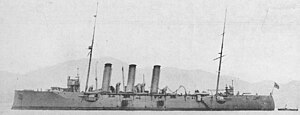Japanese cruiser Niitaka

Niitaka in November 1922
|
|
| History | |
|---|---|
|
|
|
| Name: | Niitaka |
| Namesake: | Mount Niitaka |
| Ordered: | 1897 Fiscal Year |
| Builder: | Yokosuka Naval Arsenal, Japan |
| Laid down: | 7 January 1902 |
| Launched: | 15 November 1902 |
| Completed: | 27 January 1904 |
| Struck: | 1 April 1924 |
| Fate: | Wrecked 26 August 1922 |
| General characteristics | |
| Class and type: | Niitaka-class cruiser |
| Displacement: | 3,366 long tons (3,420 t) |
| Length: | 102 m (334 ft 8 in) w/l |
| Beam: | 13.44 m (44 ft 1 in) |
| Draft: | 4.92 m (16 ft 2 in) |
| Installed power: | 9,500 ihp (7,100 kW) |
| Propulsion: |
|
| Speed: | 20 kn (23 mph; 37 km/h) |
| Complement: | 287-320 |
| Armament: | |
| Armor: |
|
Niitaka (新高?) was the lead ship of the Niitaka-class protected cruisers of the Imperial Japanese Navy. She was the sister ship of the Tsushima. Niitaka was named after Mount Niitaka in Taiwan, at the time, the tallest mountain in the Japanese Empire.
The Niitaka-class cruisers were ordered by the Imperial Japanese Navy under its 2nd Emergency Expansion Program, with a budget partly funded by the war indemnity received from the Empire of China as part of the settlement of the Treaty of Shimonoseki ending the First Sino-Japanese War. The class was intended for high speed reconnaissance missions. Niitaka was built at the Yokosuka Naval Arsenal, with the keel laid down on 7 January 1902 and launching on 15 November 1902.
In terms of design, Niitaka was very conservative in layout and similar to, but somewhat larger than the earlier Japanese-designed Suma. The increased displacement, heavier armor and lower center of gravity resulted in a more seaworthy and powerful vessel than Suma, and enabled Niitaka to outclass many other contemporary protected cruisers.
In terms of armament, it is noteworthy that Niitaka was not equipped with torpedoes. Observing problems experienced by the United States Navy during the Spanish American War with torpedo reliability and the dangers of sympathetic detonation, it was decided not to use this weapon on the new cruisers. The main battery used the standard 15.2 cm (6 in)/40 naval gun found on most contemporary Japanese cruisers.
...
Wikipedia
